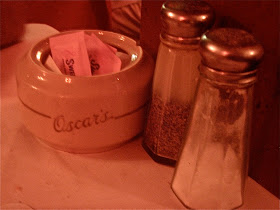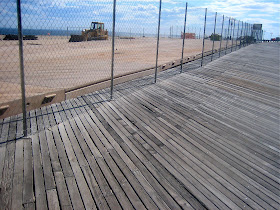Sensitive Skin magazine used to live on the Lower East Side. Now, you can only find it
archived at the NYU Fales Library, a relic of the paper-rich early 1990s. But the zine has been revived, by publisher Bernard Meisler and managing editor Tim Beckett, and it's taking a new shape online. I talked with Meisler and Beckett and they told me all about it.
 print
print, 1993
Sensitive Skin was printed on paper, back in the pre-digital days, between 1991 and 1995. What made you decide to revive it and make the leap to the small screen?Bernard: I've always been proud of what we created back in the day, and thought it would be cool to bring it back. I make my living as a developer and I realized that I could really stretch the magazine, make it what I had only dreamed of 15 years earlier - include music, videos, applications, old copies of the magazine - and to do it in a way that was cost-effective, and didn't take up all my time.
Tim: On my way back from a couple of years in the UK, I discovered a couple of copies of Sensitive Skin in my storage up in Canada. Going through them, I was struck by how fresh a lot of the writing seemed.
I think this is part of some desire for change in the air after the stifling atmosphere of the 00’s, which was such a Godawful and boring decade.
Many of the names featured in the print magazine are emblematic of the early 1990s East Village writing scenes. I often wonder what these people are up to these days. How do you see the electronic version as connecting the old voices with new ones?Bernard: They're all still doing their thing, far as I can tell. Sparrow's always publishing little bon mots on his Facebook page, which is a natural for him - as well as Mike Topp, Jose Padua, Bob Holman - they're always printing poems on Facebook, which is one of the things that inspired me – seeing how people were connecting on Facebook.
I want the magazine to become a social network, a place where people can hang out. We've only scratched the surface so far, by having a comments section, and social networking badges, at the end of every story. But we've got a lot of interesting ideas that we'll be implementing over the next few months. It's going to be very, very cool, I promise you.
Coming out of the East Village in the early 90s meant a very particular personality—transgressive, marginal, with punk and/or beat influences. The East Village is a radically different place today. Will the magazine still be identified with the East Village and, if so, what does that mean in 2010?Bernard: I've got a wife and tweenish daughters, I work for a major media corporation for my day job, and I teach software to college kids on the side. But I'm still punk as fuck! I hope that answers your question...
Seriously, what the East Village meant to me, in a word, hopefully, without sounding too corny, is "freedom." When I moved to the East Village in 1984, you could smoke dope in the Life Cafe, spray paint the walls, open an after-hours club in your living room - anybody remember Chandelier on Avenue C? – and nobody gave a fuck. I'm pretty sure 8BC, the old nightclub, got its electricity from running extension cords to adjacent buildings. Neither Nor, Limbo Lounge, the original Save the Robots - none of those places had a license. In short, you could get a place in the East Village, for like $180 a month back then, and just do whatever the fuck you wanted. You could pay your rent by working 1 day a week, or selling pot, or whatever. In a way, the Internet affords us this same kind of freedom today. It's an incredible opportunity for all artists and publishers.
Also, I remember back in 1995, people were already nostalgic for the East Village of the 1980’s. The East Village was cool until operation pressure point, or the Tompkins Square riot, or Rudy Giuliani. Of course, in 1984, people were already lamenting the lost East Village. It’s sad the way NY is getting homogenized but I can’t help but think it’s all just a part in a cycle.
Tim: I agree about that sense of freedom. For me, that had been true in the squatter’s scene in 80’s London, or Montreal for a time, even Vancouver when I first started hanging out in the punk rock scene when I was a kid.
We want to be identified with that bohemian sense of freedom commonly identified with the old East Village, but since I have lived all over the place, I tend to see it more in global terms than located in just the Village. You could go to Camden Town, London, or the Plateau in Montreal – or any formerly bohemian area in the Western World - and find pretty much the same process as the Village.
 digital
digital, 2010
The magazine used to be marketed as “dark and the disturbing.” Is that still your aim? And what place does dark and disturbing have in today’s culture?Bernard: Did it? I remember saying we “made reading literature as fun and easy as watching TV.” I don’t know,
if you want dark and disturbing, read the newspaper. If we’re in any way punk, it’s as a rebuke to all the dark and disturbing stuff that goes on around us--we acknowledge, play with it, transform it.
Tim: I’d say we’re underground. There was a phase at the end of my ‘bohemian’ life where everyone I knew was on destructive paths – narcotics and what have you. Up close that, ain’t pretty – or romantic. Certainly though, there is more than enough room – and reason – today for anger, for carving out a space outside the mainstream.
Can you say more about your slogan: “Post-beat, pre-apocalyptic”?Tim: When I was a kid, me and all my friends were convinced the apocalypse was just around the corner. It’s funny to think of it now – how we lived then, squatting in central London, living in cheap apartments right downtown - the luxury of youth!
Apocalypse did come for us in a way, just not the way we expected.
Bernard: By the way, that was only the slogan for our first issue – next time it’s gonna be “
100% vampire-free art and literature since June 2010.”
Read Sensitive Skin hereand visit their
Facebook Page here
















































